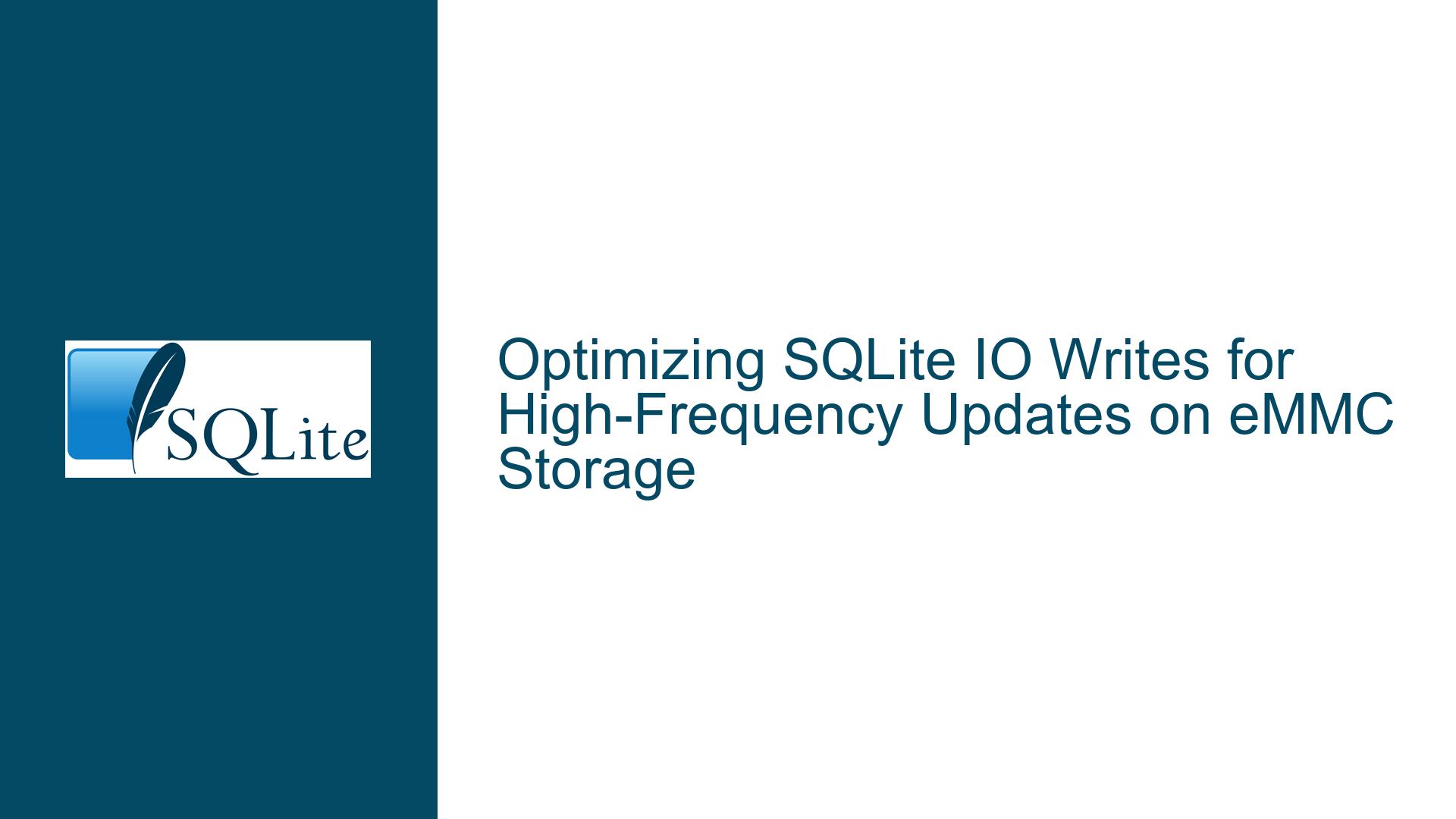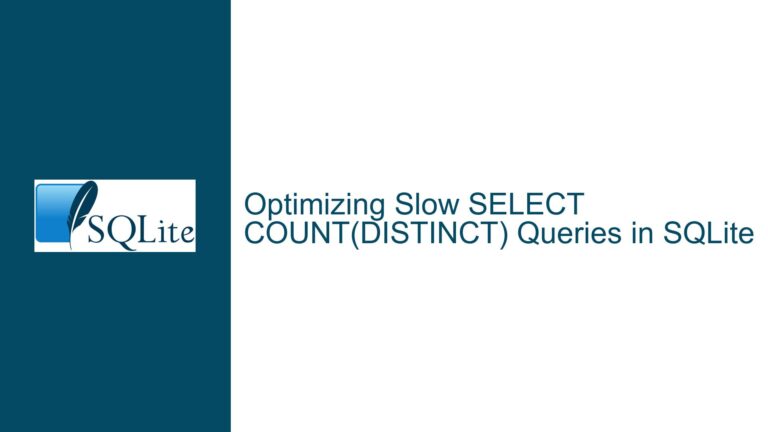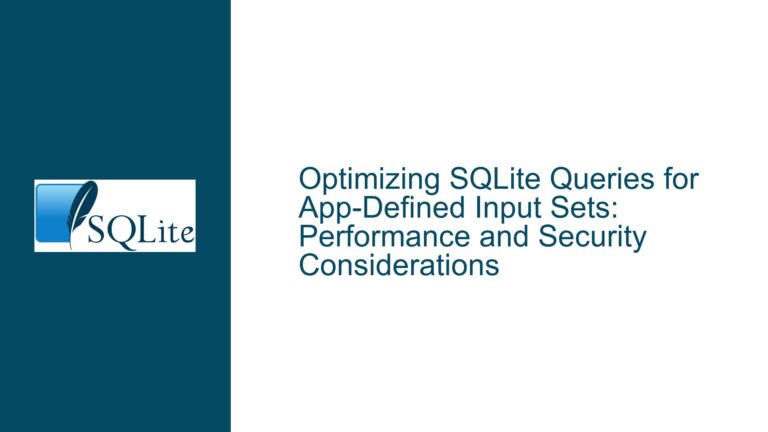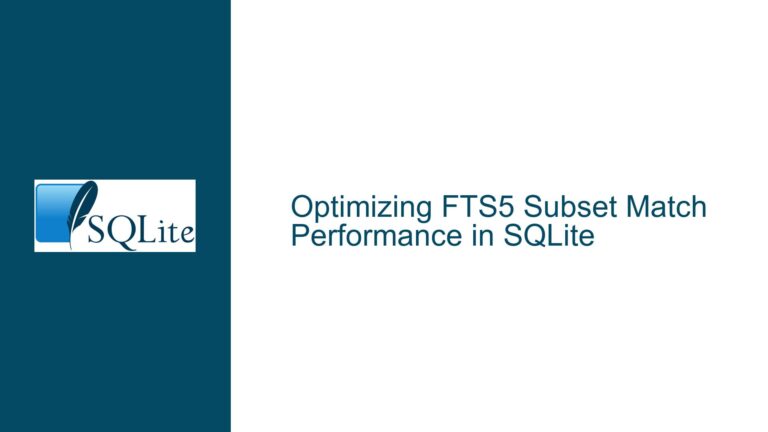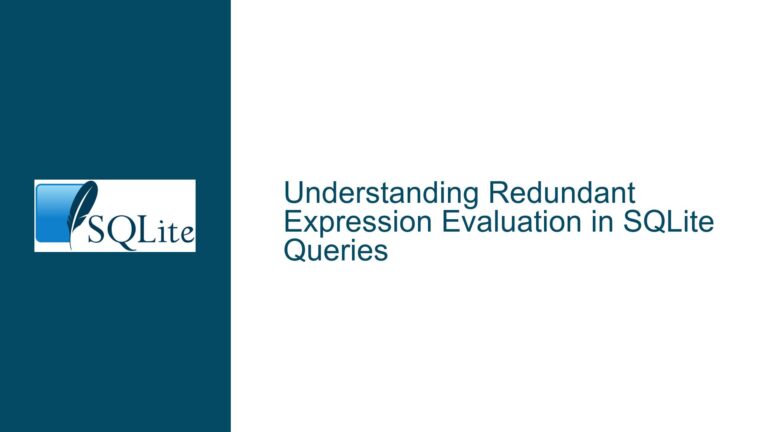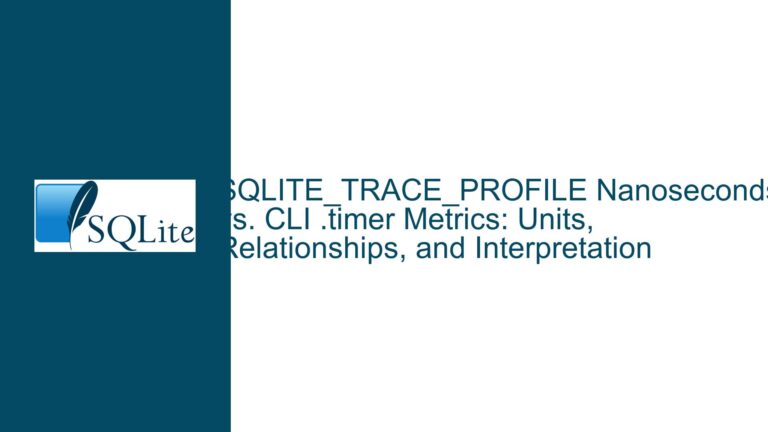Optimizing SQLite IO Writes for High-Frequency Updates on eMMC Storage
Understanding SQLite’s Page-Based Write Amplification Impact
SQLite’s page-based storage architecture creates significant write amplification when handling frequent small updates on eMMC storage devices. A user observed that inserting just one byte of data resulted in 28KB of IO writes, which stems from SQLite’s fundamental design choices and ACID compliance mechanisms.
The core issue manifests in a DIY project requiring two types of frequent database operations: message storage with 1KB writes every second and device state persistence also occurring every second. These operations, while small in data size, trigger disproportionately large IO operations due to SQLite’s paging system and journaling mechanisms.
The write amplification occurs because SQLite must maintain data integrity through several mechanisms:
- Page-level modifications: Even a single-byte change requires writing an entire page (typically 4KB)
- Journaling overhead: Each page modification needs corresponding journal entries for ACID compliance
- B-tree updates: Changes to indexes and interior B-tree pages may require additional writes
- Transaction management: Each commit operation ensures data durability but increases IO overhead
The situation is particularly problematic for eMMC storage devices which have limited write endurance. The current implementation is causing excessive wear on the storage medium, as each 32-byte update triggers approximately 28KB of actual writes to the device. This 875x write amplification factor significantly reduces the storage device’s lifespan.
SQLite’s default delete mode configuration, while ensuring data integrity, contributes to this issue by maintaining a rollback journal for each transaction. The page cache, which theoretically should help reduce IO operations, cannot fully mitigate the problem in the current setup because each operation is being committed individually rather than batched.
The challenge is further complicated by the application’s requirements for data persistence in case of power failures. However, this approach of frequent writes to handle power outages is fundamentally flawed, as it doesn’t guarantee data integrity during actual power loss events. A proper solution would need to address both the immediate technical constraints of reducing IO operations and the underlying architectural assumptions about power failure handling.
This scenario represents a classic case of the trade-offs between data integrity, performance, and storage durability in embedded systems. The current implementation prioritizes immediate data persistence at the cost of storage longevity, when alternative approaches might better balance these competing requirements.
Root Causes Behind Excessive SQLite Write Operations
The excessive write operations in SQLite environments stem from multiple interconnected factors, each contributing to the overall write amplification phenomenon. Database page management serves as the primary driver, where SQLite’s fundamental architecture requires entire pages to be written even for minimal data changes. The standard page size of 4KB aligns with operating system file system pages, creating a baseline write multiplication factor of 128x for single-byte modifications.
Transaction management mechanisms further compound the write amplification through journaling requirements. The default delete-mode journaling creates duplicate writes for each modified page, effectively doubling the IO operations to maintain ACID compliance. This journaling behavior becomes particularly impactful during high-frequency, small-data operations where the overhead significantly outweighs the actual data payload.
The B-tree structure utilized by SQLite introduces additional write requirements through index maintenance and page splits. When data modifications affect indexed columns, multiple index pages may require updates, potentially triggering page splits that cascade through the B-tree levels. Each level affected by these operations demands separate write operations, multiplying the IO impact of the original data change.
| Write Amplification Source | Typical Multiplication Factor | Impact Severity |
|---|---|---|
| Page Size Alignment | 128x | Critical |
| Journaling Overhead | 2x | High |
| B-tree Maintenance | 1.5x – 3x | Moderate |
| Index Updates | 1x – 4x per index | Variable |
Cache management limitations also play a significant role in write amplification. While SQLite implements page caching, the immediate commit requirements in many applications prevent effective write coalescing. The cache must be flushed frequently to maintain data durability guarantees, negating potential IO reduction benefits from write combining or deferred writes.
Storage device characteristics introduce another layer of complexity through internal write amplification. Flash-based storage systems, particularly eMMC devices, perform additional write operations due to their block-based nature and wear-leveling requirements. These internal processes can multiply the actual physical writes by factors of 2-10x beyond the logical writes requested by SQLite.
Power failure handling approaches often exacerbate write amplification through overly aggressive persistence strategies. Attempting to maintain system state through frequent database updates creates sustained write pressure, which storage devices must handle through additional internal write operations for garbage collection and wear leveling.
The combination of these factors creates a multiplicative effect on write operations. A single logical byte write can trigger a cascade of physical writes through multiple layers of the storage stack, each adding its own multiplication factor to the final IO operation size. This cumulative effect explains why seemingly small database operations can result in disproportionately large write volumes at the storage device level.
The relationship between write frequency and write amplification becomes particularly problematic in embedded systems with limited storage endurance. High-frequency updates prevent the database engine from optimizing write patterns, forcing each small change to incur the full write amplification overhead instead of benefiting from potential batching or coalescing optimizations.
Comprehensive SQLite Write Optimization Strategies and Implementation Methods
Write optimization in SQLite environments requires a multi-layered approach combining architectural changes, configuration adjustments, and operational modifications. The implementation of these optimizations must carefully balance data integrity requirements against storage endurance objectives.
Transaction batching serves as a primary optimization technique, allowing multiple operations to share overhead costs. By grouping operations into larger transactions, applications can significantly reduce the per-operation write amplification. The optimal batch size depends on specific application requirements, but generally falls between 1-5 minutes of accumulated operations. This approach reduces journal overhead and allows for more efficient page utilization.
| Batch Interval | Write Reduction | Data Loss Window | Implementation Complexity |
|---|---|---|---|
| 1 minute | 60x | 60 seconds | Low |
| 5 minutes | 300x | 300 seconds | Low |
| 10 minutes | 600x | 600 seconds | Medium |
| Custom | Variable | Variable | High |
Write-Ahead Logging (WAL) mode implementation offers substantial benefits for write-intensive workloads. WAL mode changes the fundamental way SQLite handles transactions, allowing for more efficient write patterns and reduced immediate disk activity. The WAL approach provides several key advantages:
| WAL Feature | Benefit | Trade-off |
|---|---|---|
| Concurrent Access | Improved reader performance | Additional storage overhead |
| Deferred Writes | Reduced immediate IO | Slightly delayed durability |
| Checkpoint Control | Flexible write scheduling | Memory management complexity |
Storage system optimization plays a crucial role in write reduction strategies. The implementation of F2FS (Flash-Friendly File System) on supporting systems can significantly improve write patterns for flash-based storage. F2FS provides native optimization for flash characteristics, reducing internal write amplification and improving overall storage endurance.
Power failure protection requires a fundamental architectural shift from frequent writes to proper hardware support. Implementation of a power backup system, such as a small UPS or supercapacitor array, provides time for proper shutdown sequences and eliminates the need for excessive state persistence writes. The hardware solution should provide:
| Component | Capacity Requirement | Purpose |
|---|---|---|
| Energy Storage | 30-60 seconds | Shutdown window |
| Voltage Monitor | 100ms response | Power loss detection |
| Control Circuit | 5V logic level | Shutdown triggering |
Database schema optimization contributes to write reduction through careful design choices. Implementing efficient indexing strategies, choosing appropriate data types, and organizing tables to minimize fragmentation can significantly reduce write amplification:
| Schema Element | Optimization Technique | Impact |
|---|---|---|
| Indexes | Minimal selective indexing | 30-50% reduction |
| Page Size | Alignment with FS blocks | 10-20% reduction |
| Column Types | Compact data types | 5-15% reduction |
Application-level caching implementation provides another layer of write optimization. By maintaining frequently updated data in memory and periodically persisting accumulated changes, applications can significantly reduce database write frequency. The caching strategy should consider:
| Cache Aspect | Implementation Detail | Effect |
|---|---|---|
| Size | 10-20% of dataset | Reduced write frequency |
| Persistence Interval | 5-10 minutes | Balanced durability |
| Invalidation Strategy | LRU with dirty tracking | Optimized writes |
Operational monitoring and maintenance procedures ensure sustained optimization effectiveness. Regular analysis of write patterns, storage device health, and performance metrics enables proactive optimization adjustments. Implementation of monitoring should include:
| Metric | Measurement Interval | Threshold |
|---|---|---|
| Write Amplification | Hourly | <50x target |
| Storage Health | Daily | >70% life remaining |
| Transaction Size | Real-time | >1KB average |
Recovery strategy implementation must account for the modified write patterns. Applications should implement robust crash recovery mechanisms that can handle larger potential data loss windows resulting from batched operations. The recovery system should include transaction logs, checkpoint management, and state verification procedures.
These optimization strategies must be implemented as a cohesive system rather than isolated changes. The interaction between different optimization layers can significantly impact their effectiveness. Regular testing and validation of the implemented optimizations ensures maintained performance and reliability while achieving the desired write reduction goals.
